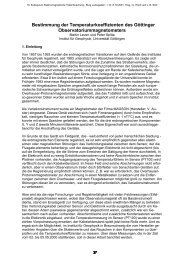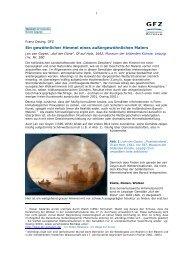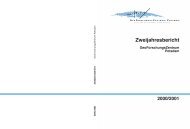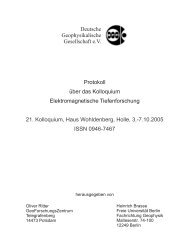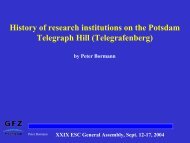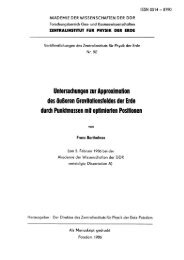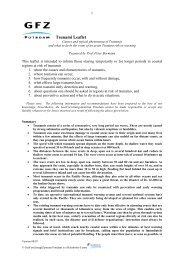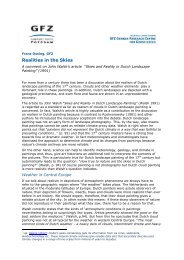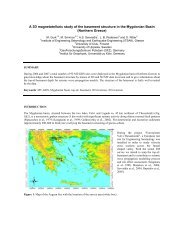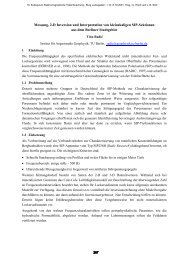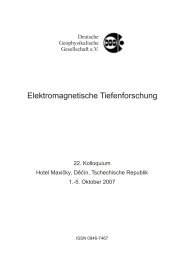Zweijahresbericht 2004/2005 - Bibliothek - GFZ
Zweijahresbericht 2004/2005 - Bibliothek - GFZ
Zweijahresbericht 2004/2005 - Bibliothek - GFZ
Erfolgreiche ePaper selbst erstellen
Machen Sie aus Ihren PDF Publikationen ein blätterbares Flipbook mit unserer einzigartigen Google optimierten e-Paper Software.
72<br />
between Earth’s outer core and mantle in order to gain a<br />
better understanding of the geodynamo process. Some<br />
more detail on these results is given in the part of Section<br />
2.3 in this report.<br />
Geomagnetic jerks<br />
Over a very short time span, a number of abrupt changes<br />
in the secular variation have been noted in the series of<br />
magnetic observatories. The cause of these so-called geomagnetic<br />
jerks is not completely known, but they may<br />
reflect the reconfiguration of hydromagnetic motions in<br />
the outer core over small scales and short time-intervals.<br />
These phenomena are difficult to study, because of their<br />
small amplitudes and the overlap of their frequency range<br />
with the effect of solar-dependent external variations.<br />
Moreover, the highly uneven coverage of the globe by<br />
magnetic observatories makes it difficult to study their<br />
geometry and evolution, and whether they are of a global<br />
nature.<br />
One way to overcome the problem of the uneven spatial<br />
distribution of time series is again to turn to satellite data.<br />
A good global coverage is obtained from satellite data in<br />
a short period of time, but satellite data are not very hel-<br />
Fig.9:Secular variation of the radial magnetic field at the core mantle boundary<br />
for epochs 1900, 1930, 1975 and 1990 using the Jackson et al. (2000)<br />
model. The extreme values (red/blue) are +/– 13 µT/yr.<br />
Säkularvariation des radialen Magnetfelds an der Kern-Mantel-Grenze für<br />
die Jahre 1900, 1930, 1975 und 1990 nach dem Modell von Jackson et al.<br />
(2000). Die Extremwerte (rot/blau) sind +/– 13 µT/a.<br />
pful if our interest is focused on a certain location over a<br />
longer period of time. Fig. 8 shows, as an example, all<br />
available CHAMP data over an area of 1° x 1° centered<br />
on the Niemegk Observatory. It is clear that the temporal<br />
resolution, even for a larger area at a fixed position, is not<br />
comparable with what observatories provide as continuous<br />
data. However, this time series can be used for interpolating<br />
the temporal behaviour of the magnetic field. This<br />
kind of plot will be a useful first step in studying secular<br />
variation, and possibly geomagnetic jerks, at a given position<br />
from satellite data.<br />
However, only the joint analysis of observatory and satellite<br />
data can really be useful for the global study of geomagnetic<br />
jerks. To circumvent the spatial and temporal<br />
distribution difficulties, the use of continuous field models<br />
derived from ground-based and satellite data, such as the<br />
Comprehensive Model by Sabaka et al. (2002, <strong>2004</strong>), is<br />
one possible solution. Chambodut and Mandea (<strong>2005</strong>) studied<br />
the temporal and spatial distribution of jerks detected<br />
in these models over the four last decades. The jerks<br />
around 1971, 1980 and 1991 are characterized by a clear<br />
bimodal behaviour of their occurrence date. So far, no<br />
geomagnetic jerk occured during the lifetime of the magnetic<br />
field satellites. A much better description of a jerk<br />
could be provided if it were to occur<br />
during the time of operation of one or preferably<br />
several satellites.<br />
South Atlantic Anomaly<br />
Another interesting feature of the core<br />
field is the so-called South Atlantic<br />
Anomaly. This is a large area of very low<br />
field intensity (less than 20000 nT) over<br />
South America, the southern Atlantic and<br />
southern Africa. Moreover, from MAG-<br />
SAT and CHAMP data we observed that<br />
the field there has been decreasing by<br />
some 8 % during the past 20 years (see<br />
Fig. 7). Recent studies have identified distinct<br />
patches of reversed magnetic flux at<br />
the poles and below Africa which could<br />
be related to the present day field decrease<br />
and might even be a hint that the geodynamo<br />
is heading towards a reversal<br />
(Hulot et al., 2002). The most prominent<br />
feature in this respect is the growing patch<br />
of reverse magnetic polarity beneath<br />
South Africa. To give an indication of<br />
recent changes, Fig. 9 shows the distribution<br />
and evolution of the radial magnetic<br />
field component at the core-mantle<br />
boundary during the past century. The<br />
model used here (Jackson et al., 2000)<br />
shows a region of reversed field direction<br />
(red area) which propagates north-eastward.<br />
At present this patch is just below<br />
South Africa. Moreover, a large longitudinal<br />
difference in field changes is observed,<br />
again with a maximum variation in<br />
<strong>Zweijahresbericht</strong> <strong>2004</strong>/<strong>2005</strong> GeoForschungsZentrum Potsdam



